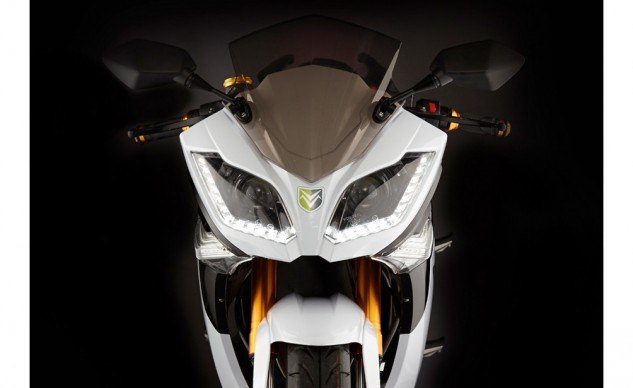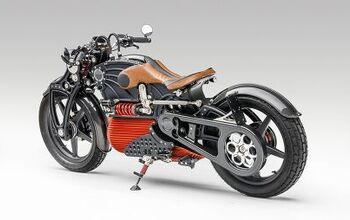Volt Motorcycles - A New Name In Electric Motorcycles

Electric motorcycles coming to you from an unexpected place.
Ireland is not a location you think of when it comes to motorcycle companies. Sure, the country has a great heritage in motorcycling, especially when it comes to racing on real roads, but as a locale for a company actually selling motorcycles? Not so much. It’s not a big stretch, then, to imagine an unconventional place to be the home of an unconventional vehicle, and with a name like Volt Motorcycles, you can likely guess what kind of unconventional vehicle Volt produces.
Volt Electric Motorcycles is the brainchild of one Colin Darby. A self-confessed gadget freak, “There are very few gadgets I don’t know about,” Darby told Motorcycle.com via a Skype interview. He also made clear that, while the parts for his line of motorbikes are manufactured in Asia, each model is assembled in Ireland. Seeing a need to relieve congestion in Europe’s (and eventually the world’s) major cities, Darby is taking it upon himself to become an electric motorcycle evangelist, offering a full line of electric motorcycles to cater to user’s different tastes, as well as their needs to get from point A to point B.
We’ll have more on Darby, Volt, and the future of electric motorcycles in another story, but for this piece we’ll focus on Volt’s five-model lineup. What’s important to note is that “Petrolheads,” as they’re called across the pond, aren’t Volt’s primary audience. Darby isn’t trying to convert those who love internal combustion. Instead Volt is looking at the “Facebook generation,” as Darby calls them – those whose lives are already filled with electronic devices and interconnectivity – as they, too, need transportation and are less concerned about clutches, gears, fuel and routine maintenance. Considering Europeans (and the rest of the world) rely on two wheels to get around far more than Americans do, Darby’s hoping the ease of entry into electric motorbikes will resonate with his audience.
From a styling perspective, Volt’s five models are distinctly different from each other, with the four scooters ranging from the cute and proper City 60, the anime-derived Volt 80, and the sophisticated Volt 90, which resembles the more mature styling cues seen on maxi scooters. Last in the line is the Volt 220, a true motorcycle design similar in size and shape to a small-displacement internal combustion sportbike. Darby notes there are more models in the pipeline, and that even the five models here are still undergoing final design tweaks.
All Volt models are powered by lithium-ion battery packs which Darby says are comprised of vertical sheet-like cells, similar to those used by Zero Motorcycles and in direct contrast to the cylindrical cells used in most electric car batteries. Because of the limited space of a scooter or motorcycle, maximum power density is required. Sheet-like cells allow more cells to be packed closer together, resulting in more power per given space compared to cylindrical cells.
Power density depends on the chemistry of each cell and that’s a closely guarded secret among all the electro-moto manufacturers. Still, Darby recalls seeing plenty of people in Zero shirts browsing intently at the Volt display during EICMA 2015. Darby says the batteries can be recharged from full depletion every day for five years before capacity is reduced to 80%. In practical terms, “You’ll likely have another electric vehicle in five years,” Darby says, meaning each battery is essentially good for the life of the vehicle.
Other Volt details include direct-drive, hub-mounted motors on each model, tires pre-installed with sealant to help reduce the damage caused in the event of a puncture, and nano-coating between the bodywork and the elements to help keep the scoot cleaner for longer and make washes easier, too.
Range is always a testy topic with electrics since it can vary greatly due to riding style and terrain, so we’ll have to go with Volt’s published numbers. The four scooter models are rated to travel 90km (56 miles) on a charge, while the Volt 220 sportbike is rated for 120km (75 miles). Those are respectable numbers, especially considering the unlikely scenario of, say, a Parisian motorist traveling 56 or 75 miles one-way on their commute. Volt claims recharging a drained battery will take six hours, and the user can plug into any standard outlet. Pricing has not been finalized. Darby says models will be available first for the European market by the end of 2016, with an eye towards North America the year after.
With the general overview out of the way, here are the models in Volt’s lineup. An important note: All the models seen here are pre-production models Volt is using for research and development. The final designs will vary slightly from what’s seen here, and Volt representatives tell us there will be components “specifically tailor-made for Volt.”
City 60
The City 60’s retro styling make it a candidate for students and the like. A 1.4 kWh lithium-ion battery is paired with a 48-volt hub-mounted motor with a top speed of 28 mph (45 kph). It’s no speed demon, but it’ll handle short commutes or errand running around town. Other details include twin rear shocks, underseat storage, centerstand and sidestand, a retro-themed speedometer, small luggage rack in the rear, and drum brakes all around. Darby says the picture above is close to the finished product, but there are still some small design tweaks to be implemented to the production models.
Volt 70
Resembling the more modern commuting scooter, the Volt 70’s angular styling is in stark contrast to the City 60. The 70 also gets higher-spec components, too. A 1.8kWh battery is paired with a 60v motor for better performance, but top speed is still 28 mph. The 70 also sees upgraded brakes compared to the City 60, with its front disc paired with the rear drum.
Volt 80
Taking a page from the Yamaha Zuma and Honda Ruckus playbooks, the Volt 80 is wild and out there, as far as scooter styling is concerned. Part dirtbike, part hooligan, the 80 features the same battery and motor as the Volt 70, but goes off on its own after that. Its gold-anodized fork is exposed, its headlight looks like it’s from a children’s book about monsters, plus it has handguards, twin shocks with remote reservoirs, and a long rear fender.
Volt 90
Things get a little more serious with the Volt 90. It’s Volt’s largest scooter, able to fit two people, and its styling is a little more mature than, say, the Volt 80. Final specifications for the 90 are still to be announced, but its motor is upgraded to 84v, while its lithium-ion battery is rated at 4.2 kWh. Range is currently claimed at 56 miles (90km).
Volt 220
Realizing that scooters may not be for everyone, the Volt 220 sportbike caters to those who prefer to throw a leg over their bike rather than through it. Top speed is increased to 75 mph, while motor gets bumped to 96v and battery upped to 4.8kWh. Range is also extended to 75 miles (120km). From there, the 220 gets an inverted fork, twin disc brakes, radial-mount calipers and a single shock. Darby is excited about the 220, but claims that the final production version will look sleeker than the prototype you see here.

Troy's been riding motorcycles and writing about them since 2006, getting his start at Rider Magazine. From there, he moved to Sport Rider Magazine before finally landing at Motorcycle.com in 2011. A lifelong gearhead who didn't fully immerse himself in motorcycles until his teenage years, Troy's interests have always been in technology, performance, and going fast. Naturally, racing was the perfect avenue to combine all three. Troy has been racing nearly as long as he's been riding and has competed at the AMA national level. He's also won multiple club races throughout the country, culminating in a Utah Sport Bike Association championship in 2011. He has been invited as a guest instructor for the Yamaha Champions Riding School, and when he's not out riding, he's either wrenching on bikes or watching MotoGP.
More by Troy Siahaan
















































Comments
Join the conversation
A "brainchild" which is just a repackaging of an existing design. The "smart" part is bringing in pieces and assemble in Ireland so there will be plenty of spare parts around.
Zero Lovers inspect these up and comers for those like Lightning who push Zero to the next level. Volt, sadly does not appear to be anything that improves the industry.
I worry items like these disappointing entry level customers and building an aversion to e-motorcycles in general. Or even how many of these well polished bad apples spoiling the industry are just Big Oil manipulation of phony "grass roots" efforts to kill the electric vehicle market once again.
Damn, people are so ridiculously judgmental. Why not wait for ride reviews once these hit the streets and see how good, or bad, they actually are. They're meant to be light-duty inner city commuters and they might actually work very well for that use AND could even prove to be reliable, like Kymcos are. Also, they're all prototypes, so designs could change and that rear tire on the 220 may not be the final choice for production models.
Personally, I hope they succeed. It would be great to see a lot more brands of electric scooters and motorcycles available on the market.